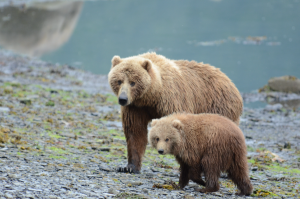This week, I want to take a closer look at whale behavior. Over the past few weeks, I’ve mentioned various behaviors, and while the reason for some behaviors seems obvious,others are not so easily explained.

Blowing or spouting: This is how whales breathe, so there is no mystery why whales blow. The spray of water is of course not from the whale’s lungs, but it is water that is blasted from the top of the blowhole when the whale exhales. What is interesting is that whales can sometimes be identified by their blow. If all I see is an exhalation and very little of the body, I can usually tell whether I’m looking at a humpback or a fin whale, the two most common whales in Uyak Bay. A fin whale’s blow is very tall and column-shaped while a humpback has a shorter, bushy blow.
Fluking: Some species commonly raise their tail flukes in the air before a deep dive, and others do not. A humpback often raises its tail, while a fin whale seldom does. Why? I don’t know. Humpbacks are more acrobatic than fin whales, and this may have something to do with it.
Breaching: This is when a whale propels its body upwards until at least 40% of it is clear of the water. Adult blue whales rarely, if ever, breach, because they are too heavy. Fin whales are also very heavy and rarely breach, but when they do, it’s impressive! Humpbacks breach fairly often, and like most large whales, a humpback breaches by raising 90% of its body clear of the water surface and then twisting and crashing down with a large smack and a torrent of spray. Killer whales are capable of acrobatic leaps and somersaults. Scientists have offered many explanations as to why
the water. Adult blue whales rarely, if ever, breach, because they are too heavy. Fin whales are also very heavy and rarely breach, but when they do, it’s impressive! Humpbacks breach fairly often, and like most large whales, a humpback breaches by raising 90% of its body clear of the water surface and then twisting and crashing down with a large smack and a torrent of spray. Killer whales are capable of acrobatic leaps and somersaults. Scientists have offered many explanations as to why

whales breach, and it is probable they breach for a variety of reasons, including mating display, annoyance, aggression, a show of strength, a means of stunning prey, or removing parasites. I suspect one of the main reasons whales breach is because it’s fun. Wouldn’t you do that if you could?
Slapping: This category includes flipper slapping, tail slapping, dorsal fin slapping,  lobtailing or tail lobbing, and head slapping. Possible explanations for this behavior include a display, aggression, communication, or a means of stunning prey. Humpbacks often lobtail and flipper slap, and both actions make a very loud noise, so it would be an
lobtailing or tail lobbing, and head slapping. Possible explanations for this behavior include a display, aggression, communication, or a means of stunning prey. Humpbacks often lobtail and flipper slap, and both actions make a very loud noise, so it would be an  effective means of communication.
effective means of communication.
Spyhopping: This is simply when a whale sticks its head out of the water and

looks around. By doing this, it can locate a passing vessel or find escape holes or channels in pack ice. Whales may also spyhop to look at people on a boat. Since visibility is better in air than it is in water, it only makes sense that a whale might want to stick its head out of the water to get a better look.
 Flipper Waving: Whales sometimes float on their backs and wave their fins in the air. No one knows why, but it looks fun.
Flipper Waving: Whales sometimes float on their backs and wave their fins in the air. No one knows why, but it looks fun.
Sleeping: One of our brilliant summer guests (I’m talking about you, Karin!) asked me how whales sleep. I was embarrassed to admit that I didn’t know, so I checked and was quite surprised by the answer. Since whales are mammals, they must breathe air, so how do they sleep without drowning? Research has shown that they either sleep while swimming slowly next to another animal, or they rest vertically or horizontally in the water. Scientists believe that when a whale or dolphin sleeps, it shuts down only half of its brain, and the other half stay awake. The side that is awake watches for predators or other dangers and also signals the animal to rise to the surface and take a breath of air every few minutes. After approximately two hours, the whale shuts down the active portion of its brain and the other side wakes up and takes over. To read more about this amazing behavior, check out this article.

There are many other whale behaviors, including feeding behaviors that I did not cover here. If you have any questions, please ask. Also, if you love mysteries, sign up for my monthly Mystery Newsletter. I am currently working on the first issue, and I apologize to those of you who have already signed up for it. It is taking me longer than I anticipated to get the first installment ready to go.


























